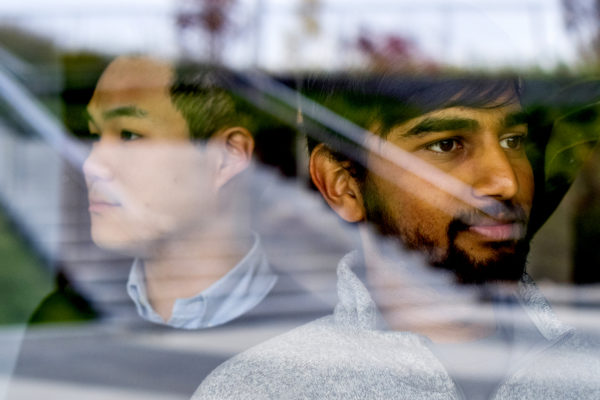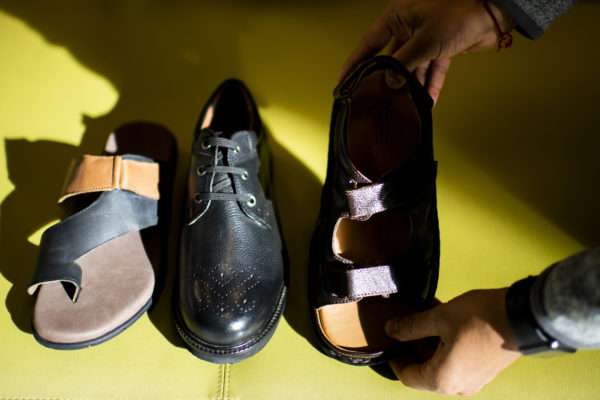
Great ideas can come to you when you least expect it. Take the shower, for example. One minute you’re soaping up the loofah, the next you’re hatching an elaborate plan for the next multi-million dollar app. Or, if you’re Vidhan Bhaiya, the light bulb goes off at a family wedding, surrounded by brightly colored saris and the thumping of drums.
“This started off—as all good things do—at an Indian wedding,” says Bhaiya, who is a chemical engineering student at Northeastern, and entrepreneur on the side—for now.
Bhaiya’s bout of inspiration occurred three Decembers ago. His favorite uncle was there, clad in his signature fancy suit. But Bhaiya recalls him sitting down most of the night. When it was time for group photos, his uncle sort of shuffled toward the back.
“What’s going on?” Bhaiya later asked his dad. Diabetic neuropathy. His uncle was suffering from a condition that damages nerves in the legs and feet of people with diabetes. And lack of proper footwear kept him from enjoying the festivities that evening.
Northeastern students Danny Jooyoung Kim and Vidhan Bhaiya, co-founders of Dr. Brinsley. Photo by Matthew Modoono/Northeastern University
That’s when the idea for Dr. Brinsley was born. Bhaiya enlisted the help of his best friend, Danny Jooyoung Kim, an equally entrepreneurial-minded pharmacy student at Northeastern, to start a footwear company that caters to patients with diabetes who don’t want to sacrifice style for function.
“We find the current footwear [for people with diabetes] is ineffective, unsophisticated, and on top of that, sometimes expensive,” Bhaiya says. “We said our footwear is gonna be durable, functional and stylish. These three, we believe, are the pillars of our core branding.”ho don’t want to sacrifice style for function.
While online retailers, including Amazon, carry the shoes, they’re not in U.S. brick-and-mortars just yet. It’s not the easiest market to break into, says Bhaiya. But, in India, they’re sold in 85 hospitals and clinics, retailing between $10 and $40. They’re sold in parts of Singapore, South Africa, Bahrain, and Colombia. Soon, Dr. Brinsley will have a bigger presence in the Middle East.
The design and development of the shoes has undergone several iterations, and has required Bhaiya to travel back and forth to parts of India and Italy, interviewing thousands of patients, doctors, and podiatrists, and spending hours at his uncle’s manufacturing plant in Chennai.
“We said, OK, diabetic footwear is not a new invention. People have worked on it before, but we want to try to make it look good,” says Bhaiya. “It’s hard.”
With several prototypes under their belts, they feel like they’re finally getting there. Today, the company offers style-conscious diabetes sufferers eight different varieties of both men’s and women’s shoes.

The shoes are made out of leather, and constructed with people with diabetes in mind. The footbed is made out of crystallized memory foam, which helps to evenly distribute the pressure of the foot. Built-in metatarsal guards, arch and heel support, leather walls, and a dual density sole complete the design.
The idea is to protect people with diabetes who oftentimes will lose sensation in their feet and not realize they’ve stepped on a nail or other sharp object, risking cuts and bruises. In the worst case scenarios, such an injury is so severe that it can result in amputation of a leg, or even death.
Bhaiya and Kim have high aspirations for the company.
“We want to build a product where you could put this in a Foot Locker, or fill-in-the-blank retail store you shop for shoes at, and not be able to distinguish between your Air Nikes and your diabetic shoes,” says Kim.
They realize that success is contingent upon educating patients.
“Awareness about this footwear is extremely low among diabetics, sometimes among the medical community as well,” says Bhaiya. “India has 80 million diabetics, with over 85 million people in the pre-diabetic stage. It’s incredible. And there’s no one brand that comes to mind when you think about diabetic footwear. We sort of want to be that brand.”
So far, the feedback has been positive, says Bhaiya. His uncle, for one, is a fan.
“He really loved them,” says Bhaiya. “He’s been pushing us through. Both of our families are very big influences for sanity, for counsel, for everything.”
In April, their business idea won the Global Impact Award at the Schulze Entrepreneurship Challenge, a contest held at the University of St. Thomas in Minnesota. They were among 25 student ventures selected to compete.
The award came with a $12,500 cash prize. In addition to prize money from pitch competitions, the company is being supported mostly through grants and anything Bhaiya and Kim can stash away from their co-op jobs. Northeastern has been a source of major support, the students say, both in providing funding opportunities and mentorship.
“The great thing about Northeastern is we have all these talents, and we have all this brain power within our reach,” says Kim. “I mean, where else can a pharmacy student and an engineer be able to work together, sit down and toss ideas around, and get input from business teachers, and get support from the president?”
 Someday, Bhaiya hopes to see the business become self-sustainable. He graduates in May and plans to focus on the business full-time. Meanwhile, Kim will continue onto his fourth year of pharmacy school at Northeastern, and as the vice president of business development at Dr. Brinsley.
Someday, Bhaiya hopes to see the business become self-sustainable. He graduates in May and plans to focus on the business full-time. Meanwhile, Kim will continue onto his fourth year of pharmacy school at Northeastern, and as the vice president of business development at Dr. Brinsley.
“I’ve grown up around three generations of entrepreneurs, and beyond power, sustenance and having something that lasts motivates me to a great extent,” says Bhaiya.
Originally posted at News@Northeastern by Khalida Sarwari, linked here.
